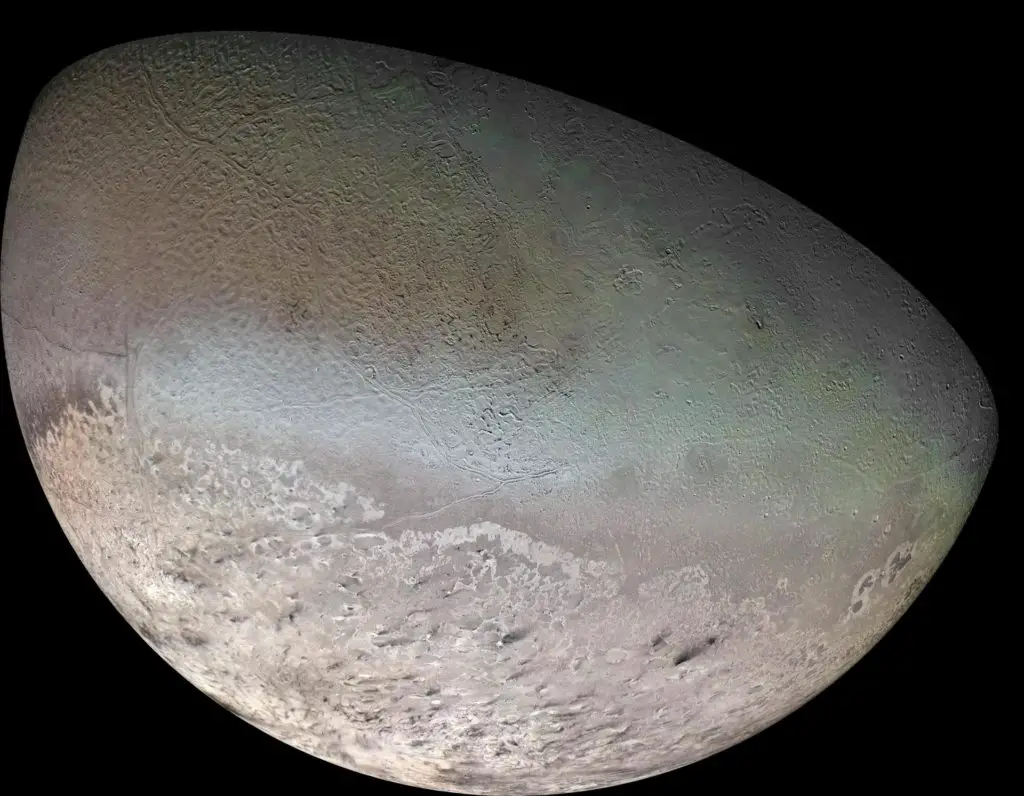Triton is the largest moon in the Neptune system and one of the largest in the solar system. It was discovered on October 10, 1846, just 17 days after the discovery of the planet it orbits. Shall we attempt to investigate it further? 33 years ago, the Voyager 2 spacecraft flew over the royal blue clouds of Neptune, which is at the far end of our solar system. This revealed a world unlike any other, with unpredictable weather, a source of energy, and a different location than its close sibling Uranus.
The tiny spacecraft’s observations of Neptune yielded many more questions than answers as it passed by one of the solar system’s strangest moons, Triton. After passing over Neptune’s north pole, voyager 2 headed southwards through the giant planet’s ring plane toward Triton, which had grown steadily larger over the previous 15 months.
On August 25th, 1989, the moon covered more than half of the spacecraft’s narrow angle lens, but despite its At the time, it was believed that Triton’s diameter was even greater than 5,000 kilometers, competing with Ganymede for the title of largest moon in the solar system. Image motion compensation techniques Trialled at Uranus came into their own and held the spacecraft steady enough to acquire some of the most astonishing map quality.
Moons in retrograde orbits cannot form in the same region of the solar nebula as the planets they orbit, so Triton must have been captured from elsewhere. It may therefore have originated in the Kuiper belt, the ring of small icy objects extending beyond the orbit of Neptune believed to be the source of the majority of short period comets. Triton is just slightly larger than Pluto, and their composition is virtually identical, which has led to the notion that they have a same ancestor.
Before its capture, Triton had a mass companion similar to Pluto’s satellite Karen with which it formed a binary system. When the two bodies got too close to Neptune, Triton transferred all of its orbital energy to its companion, who was ejected from the system while Triton was captured and forced to follow a retrograde orbit. Some scientists believe that the planet formerly had a family of mid-sized moons, but that the arrival of Triton scattered them, destroyed them, or expelled them from the Neptunian system entirely. Triton’s retrograde orbit is the peculiarity that, more than any other, makes it a world worthy of a fantasy story.
What can be said about the planet’s surface?
Another record is set by triton It is the solar system’s coldest body with a surface temperature of minus 230 degrees Celsius, colder than even Pluto. Its low temperature and substantial bulk allow it to maintain a scant atmosphere made of 99 molecular nitrogen and the remainder methane and carbon monoxide. At that temperature and distance from the Sun, one would expect the surface pressure to be less than 170,000th of Earth’s.
A ball of ice with several impact craters A monotone landscape fixed in time, while the surface of Triton is perpetually replenishing. Only a third of Triton’s surface was seen in voyager 2’s finest resolution photos, which revealed a peculiar, ubiquitous green terrain dubbed “cantaloupe” due to its textural similarities to the hard skin of a cantaloupe melon. The cantaloupe terrain is crisscrossed by long interconnected ridges that are believed to have been caused by one or more epochs of melting and near complete resurfacing of Triton.
Speculations continue that the heat source for this melting is most likely the tremendous heat associated with the moon’s capture by Neptune and the subsolar orbit. Mazumba, the largest of its few visible craters, measuring only 27 kilometers in diameter, indicating that its present surface is quite young.
Spectroscopy analysis indicated the presence of five distinct types of ice in the soil water. Methane, Carbon dioxide, Nitrogen and Carbon monoxide are greenhouse gases. A solid solution of nitrogen with traces of methane and carbon monoxide covers more than half of the moon. Most of the features observed by Voyager 2 are thought to be solid water ice that is frozen so hard that it has the consistency of rock at these frigid temperatures.
It has been suggested that liquid may still be erupting cryo-volcanically from the depths of Triton, freezing onto the surface, and obliterating the surface. Rosa nitrogen is in fact very transparent, allowing light to penetrate it for several meters. It is sufficient for the deeper ice to be warmed by a couple of degrees for it to sublimate, generating the pressure necessary to erupt to the surface and to project into the tenuous atmosphere a column of nitrogen crystals and dark dust consisting of organic or rocky material.
There is no connection with endogenous activity, such as that active on Europa, but according to many planetologists, Rosa nitrogen could. However, tidal friction is not the only source of heat within an earth body; there is also radiogenic heating, which is the heat produced by the decay of radioactive isotopes within a moon or planet, and this process can create heat over billions of years.
Doesn’t heat plus water equal life?
Nicknamed trident for its three-pronged objectives, the mission would probe the magnetic field to determine the presence of an ocean, map the entire surface, and use a camera to measure the activity of plumes. in 2021, however, NASA prioritized missions to Venus, believing that simply flying over Triton by the trident probe would not yield significant scientific results.
Before orbital insertion at Neptune, a 220 kilogram atmospheric probe will be deployed from the orbiter and drop 37 minutes into Neptune’s atmosphere to explore its composition, dynamics, and processes. The orbiter would then orbit progressively closer to Neptune and its rings on a grand finale similar to the grand finale of Cassini and eventually be destroyed in Neptune’s atmosphere for planetary protection purposes, but these are all things that will happen.
![]()
